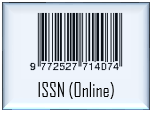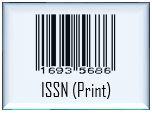MOLECULAR DOCKING OF COMPOUNDS FROM Chaetomium Sp. AGAINST HUMAN ESTROGEN RECEPTOR ALPHA IN SEARCHING ANTI BREAST CANCER
(1) Faculty of Pharmacy, Sanata Dharma University, Maguwoharjo, Sleman, Yogyakarta 55282
(2) Program of Pharmacy, Faculty of Science and Technology, Ma Chung University, Malang 65151
(*) Corresponding Author
Abstract
Keywords
Full Text:
PDFReferences
Abdel-Lateff, A., 2008. Chaetominedione, a new tyrosine kinase inhibitor isolated from the algicolous marine fungus Chaetomium sp. Tetrahedron Lett, 49(45), 6398-6400.
Eiler, S., et al., 2001. Overexpression, purification, and crystal structure of native ER alpha LBD. Protein Expr Purif, 22(2), 165-73.
Ferlay, J., et al., 2007. Estimates of the cancer incidence and mortality in Europe in 2006. Annals of Oncology, 18(3), 581-592.
Horwitz, K.B. and W. McGuire, 1978. Estrogen control of progesterone receptor in human breast cancer: correlation with nuclear processing of estrogen receptor. Journal of Biological Chemistry, 253(7), 2223-8.
Hussain, M.S., et al., 2012. Current approaches toward production of secondary plant metabolites. Journal of Pharmacy and Bioallied Sciences, 4(1), 10.
Kandavel, D. and S. Sekar, 2015. Endophytic fungi from Phyllanthus amarus Schum. & Thonn. capable of producing phyllanthin, hypophyllanthin and/or related compounds. Int J Pharm Pharm Sci, 7(5).
Kitchen, D.B., et al., 2004. Docking and scoring in virtual screening for drug discovery: methods and applications. Nature reviews Drug discovery, 3(11), 935-949.
Kumar, A., et al., 2013. Isolation, purification and characterization of vinblastine and vincristine from endophytic fungus Fusarium oxysporum isolated from Catharanthus roseus. PloS one, 8(9), e71805.
Lane, N.E., 2006. Epidemiology, etiology, and diagnosis of osteoporosis. American Journal of Obstetrics and Gynecology, 194(2), S3-S11.
Li, H., et al., 2009. An effective docking strategy for virtual screening based on multi-objective optimization algorithm. BMC Bioinformatics, 10(1), 58.
Li, H.-Q., et al., 2011. Antifungal metabolites from Chaetomium globosum, an endophytic fungus in Ginkgo biloba. Biochemical Systematics and Ecology, 39(46), 876-879.
Li, P., et al., 2015. Paeonol produced by Chaetomium sp., an endophytic fungus isolated from Paeonia suffruticosa. Phytochem Lett, 13, 334-342.
Marwah, R.G., et al., 2007. Musanahol: a new aureonitol-related metabolite from a Chaetomium sp. Tetrahedron, 63(34), 8174-8180.
Patrick, G.L., 2013. An Introduction to Medicinal Chemistry. Fifth Edition. Oxford University Press.
Qin, J.-C., et al., 2009. Bioactive metabolites produced by Chaetomium globosum, an endophytic fungus isolated from Ginkgo biloba. Bioorg Med Chem Lett, 19(6), 1572-1574.
Ruch, R.J., Cheng, S.-J. and J.E. Klaunig, 1989. Prevention of cytotoxicity and inhibition of intercellular communication by antioxidant catechins isolated from Chinese green tea. Carcinogenesis, 10(6), 1003-1008.
Stierle, A., G. Strobel, and D. Stierle, 1993. Taxol and taxane production by Taxomyces andreanae, an endophytic fungus of Pacific yew. Science, 260(5105), 214-216.
Strobel, G.A., 2003. Endophytes as sources of bioactive products. Microb Infect, 5(6), 535-544.
Wang, Y., et al., 2012. Bioactive metabolites from Chaetomium globosum L18, an endophytic fungus in the medicinal plant Curcuma wenyujin. Phytomedicine, 19(3), 364-368.
Wang, M.-H., et al., 2015. Stereochemical determination of tetrahydropyran-substituted xanthones from fungus Chaetomium murorum. Chin Chem Lett, 26(12), 1507-1510.
Yang, S.-X., et al., 2011. Toxic polyketides produced by Fusarium sp., an endophytic fungus isolated from Melia azedarach. Bioorganic & Medicinal Chemistry Letters, 21(6), 1887-1889.
Yang, L., et al., 2013. How much do van der Waals dispersion forces contribute to molecular recognition in solution? Nat Chem, 5(12), 1006-1010.
Zhang, Q., et al., 2012. Chemical and bioactive diversities of the genus Chaetomium secondary metabolites. Mini reviews in medicinal chemistry, 12(2), 127-148.
Zhao, J., et al., 2010. Endophytic fungi for producing bioactive compounds originally from their host plants. Curr Res, Technol Educ Trop Appl Microbiol Microbial Biotechnol, 1, 567-576.
DOI: https://doi.org/10.24071/jpsc.00128
Refbacks
- There are currently no refbacks.
Copyright (c) 2016 Journal of Pharmaceutical Sciences and Community
Jurnal Farmasi Sains dan Komunitas (Journal of Pharmaceutical Sciences and Community)
Published by Faculty of Pharmacy, Universitas Sanata Dharma Yogyakarta

This work is licensed under a Creative Commons Attribution 4.0 International License.













.png)













